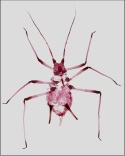Classification
Aphidinae: Macrosiphini
Diagnosis
The apterae are dark brown and shiny. The siphunculi and antennae are dark while cauda and antennal segment III are pale yellow. Siphunculi dark at the base and apex, middle portion relatively pale. The alatae are completely dark brown. The aphids are found on all parts of the plants. The aphid drops down to the ground on disturbance. This aphid is sometimes found in association with Hyperomyzus carduellinus.
Antennae almost equal to or 1.05 times as long as body. Segment three shorter than segment IV and V put together. Siphunculi 1.7 times as long as cauda. Cauda with 20-30 hairs. This species can be differentiated from other species of Uroleucon based on number of rhinaria. The third segment of antenna possesses 16-31 rhinaria.
Diagnosis
Europe, Africa, Middle East, Japan, Pakistan, India (Andhra Pradesh; Himachal Pradesh; Karnataka; Manipur; Meghalaya; Sikkim; Uttar Pradesh; Tamil Nadu).
Distribution
Asteraceae: Sonchus arvensis L., S. oleraceus L.
Host plant(s)
Aptera: Length of body 3.36, width 1.41; antennae 3.53, segments III: IV: V: VI 0.89: 0.56: 0.51: (0.18+0.85); u.r.s. 0.18; h.t.2 0.19; siphunculus 0.99; cauda 0.58.
Alata: Length of body 2.85, width 0.97; antennae 3.0, segments III: IV: V: VI 0.69: 0.47: 0.43: (0.12+0.69); u.r.s. 0.13; h.t.2 0.15; siphunculus 0.82; cauda 0.49.
Measurements
November-December, July-March.
Seasonal occurrence
Coleoptera: Coccinellidae: Coccinella transversalis F., Hippodamia variegata (Goeze).
Diptera: Syrphidae: Episyrphus balteatus (De Geer), Ischiodon scutellaris (F.).
Hymenoptera: Braconidae: Aphidiinae: Aphidius sonchi Marshall, Ephedrus niger Gautier et al., Trioxys basicurvus Shujauddin.





